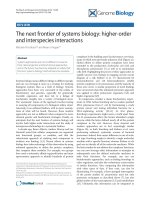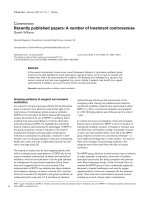Báo cáo y học: "Recently published papers: of head injuries, high frequencies and haemodynamic optimization" pps
Bạn đang xem bản rút gọn của tài liệu. Xem và tải ngay bản đầy đủ của tài liệu tại đây (35.2 KB, 3 trang )
468
HFOV = high-frequency oscillatory ventilation; ICP = intracranial pressure; PEEP = positive end-expiratory pressure.
Critical Care December 2002 Vol 6 No 6 Kirk-Bayley and Venn
That we have come a long way in recent years in the
management of head injuries is apparent; that we need to
travel further down this road is more so. However, are some
of our current management strategies actually deleterious?
Coles and coworkers [1] raised the prospect of yet another
double-edged sword. Examining hyperventilation for control
of cerebral hypertension, they used positron emission
tomography to map regional cerebral blood flow. Defining the
critical hypoperfusion threshold as a cerebral blood flow of
10 ml/100 g per min, they reduced arterial partial carbon
dioxide tension from 4.8 to 3.9 kPa in healthy volunteers and
head-injured patients, and found a significant increase in the
volume of hypoperfused tissue despite improvements in
intracranial pressure (ICP) and cerebral perfusion pressure.
Despite the availability of evidence-based national guidelines
for the management of the severely head-injured patient [2],
Bulger and colleagues [3] showed that adherence to these
guidelines, at least in the USA, is still very variable. Looking at
34 centres, those investigators found considerable variations
in care, especially when they looked at numbers of patients
being intubated before hospital admission or undergoing ICP
monitoring. Only 35% of centres placed ICP monitors in more
than 50% of patients who met the recommended criteria. The
centres analyzed were classified as either aggressive or
nonaggressive in terms of ICP monitor placement, and it was
shown that management in the former yielded a significant
reduction in mortality risk (hazard ratio 0.43, 95% confidence
interval 0.27–0.66), despite the fact that it has not yet been
shown elsewhere that lowering ICP directly affects outcome.
However, there were more neurosurgical consultations and
significantly more head computed tomography scans
conducted in the aggressive group. As Bulger and colleagues
pointed out, mortality is not the best primary end-point, and
long-term functional neurological status is more important.
The management of head injury needs to be focused on from
injury to outcome, leaving many modalities available for
manipulation, as highlighted by Marik and colleagues in their
excellent review [4]. In any case, as Wasserberg pointed out
[5], national guidelines are there to be followed, and there is
work to be done.
Attention has recently been focused on another treatment
strategy, namely high-frequency oscillatory ventilation
(HFOV). Over the years, HFOV has shown promise in animal
models, but no conclusive benefits in humans have yet been
reported. Courtney and colleagues [6] conducted an
investigation to determine whether ventilation by this method
benefited very low birthweight infants and found that, when
compared with synchronized intermittent mandatory
ventilation, recipients of HFOV could be successfully
extubated at a median of 8 days younger. Also, at 36 weeks
there may be a small benefit in terms of mortality and oxygen
requirement. However, Johnson and coworkers [7] examined
the use of HFOV in preterm infants in another large
multicentre trial, and did not find significant reductions in
infant mortality or development of chronic lung disease.
Nevertheless, both groups concluded that, despite previous
worries of worsened intracranial pathologies with HFOV, this
was not demonstrated, perhaps validating its safety in infants.
What of HFOV use in adults? Case reports and observations
have been reported, but until now no randomized controlled
trials had appeared in the literature. Derdak and colleagues
[8] looked at HFOV in adults with acute respiratory distress
syndrome. They concluded that HFOV is at least safe in
adults and found an unsustained initial improvement in
oxygenation, but what we really need is a study powered to
show differences in outcome. Although HFOV may not have
been shown to be of benefit in adults with acute respiratory
Commentary
Recently published papers: of head injuries, high frequencies
and haemodynamic optimization
Justin Kirk-Bayley
1
and Richard Venn
2
1
Senior House Officer, Worthing Hospital, Lyndhurst Road, Worthing, West Sussex, UK
2
Consultant in Anaesthesia and Intensive Care, Worthing Hospital, Lyndhurst Road, Worthing, West Sussex, UK
Correspondence: Justin Kirk-Bayley,
Published online: 6 November 2002 Critical Care 2002, 6:468-470 (DOI 10.1186/cc1850)
This article is online at />© 2002 BioMed Central Ltd (Print ISSN 1364-8535; Online ISSN 1466-609X)
469
Available online />distress syndrome, high respiratory rate with low tidal
volumes (and positive end-expiratory pressure [PEEP]) has
[9]. However, could the high respiratory rate lead to gas
trapping and induce significant increases in intrinsic PEEP in
these patients? Richard and colleagues [10] set out to find
out, by comparing ventilation at conventional and high
respiratory rates, and confirmed this to be the case. The
consideration, then, is that total PEEP should be measured,
in addition to recommendations regarding plateau pressures.
Kern and Shoemaker [11] recently looked back at the
successes of haemodynamic goal-directed therapy in a meta-
analysis of randomized controlled studies aiming for normal
or supranormal values in high-risk elective surgery, trauma
and sepsis patients. Their findings confirmed further that
when therapy is aimed at improving oxygen delivery
(especially in the severely ill, in whom control group mortality
was greater than 20%), goals must be achieved early, before
the development of organ failure, if significant improvements
in outcome are to be achieved.
The search for haematological markers as predictors of poor
outcome in patients with severe sepsis continues, and Beer
and coworkers [12] looked at calcitonin gene-related peptide
and substance P. They found that whereas elevation in levels
of substance P is only associated with lethal outcome during
the late course of sepsis, high calcitonin gene-related peptide
levels were found in patients with lethal outcome at the onset
of sepsis and remained elevated throughout their course. As
well as further implicating involvement of the neuroendocrine
system in sepsis, have they found a highly predictive marker?
Time and further investigation will surely tell.
Are we drawing too many blood samples from our patients?
What cutoffs should we use when deciding when patients
should red blood cell transfusion? More importantly, what
effect does red blood cell transfusion have on outcome? In a
paper from the Anaemia and Blood Transfusions in Critical
Care investigators, Vincent and colleagues [13] addressed
some of these questions. Their snapshot of transfusion
practices in Western European intensive care units highlights
our practices and the issues surrounding them. They found
average blood loss through sampling to be 41 ml/day, with
total volumes being proportional to severity of illness. Of
patients who stayed on the intensive care unit for longer than
1 week, 73% received transfused blood. The average
haemoglobin concentration before transfusion across the
study was only 8.4 g/dl. This is lower than anticipated from
previous research [14], and may be as a direct result of this.
The finding that should provoke most interest, however, is the
association between mortality and transfusion. Vincent and
colleagues used a propensity scoring system to identify two
distinct groups and control for confounders, and found an
odds ratio of 1.37 for mortality in transfusion recipients when
compared with similar nonrecipients. However, scrutiny
reveals that the confidence intervals for this verge on unity,
pointing out the problems of analysis with just so many
variables. One day soon someone may take up the gauntlet
of a matched interventional study so that we can really be
sure that transfusion is as beneficial as we would hope.
Finally, and perhaps fittingly so, what should intensivists do
when, despite their best efforts, patients’ prognoses are
hopeless? Holzapfel and colleagues [15] examined the
controversial issue of withholding and withdrawing life
support from patients who are dying on the intensive care
unit. They rightly pointed out that, although we are well
trained in how to treat disease, we may be not so well trained
in treating the clearly dying, and lack of consensus between
health care professionals does little to ameliorate a difficult
situation. They describe a four-step protocol with no limitation
in care and three gradations of treatment limitation, with daily
review of patient status. However, what is perhaps most
striking about their protocol is the obligate involvement of
patients’ surrogates as well as the health care team as an
absolute whole. Protocols such as this may well facilitate the
making of medical decisions to withhold or withdraw life-
sustaining treatments.
Competing interests
None declared.
References
1. Coles JP, Minhas PS, Fryer TD, Smielewski P, Aigbirihio F,
Donovan T, Downey SP, Williams G, Chatfield D, Matthews JC, et
al.: Effect of hyperventilation on cerebral blood flow in trau-
matic head injury: clinical relevance and monitoring corre-
lates. Crit Care Med 2002, 30:1950-1959.
2. Brain Trauma Foundation, American Association of Neurological
Surgeons, Joint Section on Neurotrauma and Critical Care:
Guidelines for the management of severe head injury. Brain
Trauma Foundation, American Association of Neurological
Surgeons, Joint Section on Neurotrauma and Critical Care. J
Neurotrauma 1996, 13:641-734.
3. Bulger EM, Nathens AB, Rivara FP, Moore M, MacKenzie EJ,
Jurkovich GJ: Management of severe head injury: institutional
variations in care and effect on outcome. Crit Care Med 2002,
30:1870-1876.
4. Marik PE, Varon J, Trask T: Management of head trauma. Chest
2002, 122:699-711.
5. Wasserberg J: Treating head injuries. BMJ 2002, 325:454-455.
6. Courtney SE, Durand DJ, Asselin JM, Hudak ML, Aschner JL,
Shoemaker CT: High-frequency oscillatory ventilation versus
conventional mechanical ventilation for very-low-birth-weight
infants. N Engl J Med 2002, 347:643-652.
7. Johnson AH, Peacock JL, Greenough A, Marlow N, Limb ES,
Marston L, Calvert SA: High-frequency oscillatory ventilation
for the prevention of chronic lung disease of prematurity. N
Engl J Med 2002, 347:633-642.
8. Derdak S, Mehta S, Stewart TE, Smith T, Rogers M, Buchman
TG, Carlin B, Lowson S, Granton J: High-frequency oscillatory
ventilation for acute respiratory distress syndrome in adults: a
randomized, controlled trial. Am J Respir Crit Care Med 2002,
166:801-808.
9. The Acute Respiratory Distress Syndrome Network: Ventilation
with lower tidal volumes as compared with traditional tidal
volumes for acute lung injury and the acute respiratory dis-
tress syndrome. The Acute Respiratory Distress Syndrome
Network. N Engl J Med 2000, 342:1301-1308.
10. Richard JC, Brochard L, Breton L, Aboab J, Vandelet P, Tamion F,
Maggiore SM, Mercat A, Bonmarchand G: Influence of respiratory
rate on gas trapping during low volume ventilation of patients
with acute lung injury. Intensive Care Med 2002, 28:1078-1083.
470
Critical Care December 2002 Vol 6 No 6 Kirk-Bayley and Venn
11. Kern JW, Shoemaker WC: Meta-analysis of hemodynamic opti-
mization in high-risk patients. Crit Care Med 2002, 30:1686-
1692.
12. Beer S, Weighardt H, Emmanuilidis K, Harzenetter MD, Matevoss-
ian E, Heidecke CD, Bartels H, Siewert JR, Holzmann B: Sys-
temic neuropeptide levels as predictive indicators for lethal
outcome in patients with postoperative sepsis. Crit Care Med
2002, 30:1794-1798.
13. Vincent JL, Baron JF, Reinhart K, Gattinoni L, Thijs L, Webb A,
Meier-Hellmann A, Nollet G, Peres-Bota D: Anemia and blood
transfusion in critically ill patients. JAMA 2002, 288:1499-
1507.
14. Hebert PC, Wells G, Blajchman MA, Marshall J, Martin C,
Pagliarello G, Tweeddale M, Schweitzer I, Yetisir E: A multicen-
ter, randomized, controlled clinical trial of transfusion require-
ments in critical care. Transfusion Requirements in Critical
Care Investigators, Canadian Critical Care Trials Group. N
Engl J Med 1999, 340:409-417.
15. Holzapfel L, Demingeon G, Piralla B, Biot L, Nallet B: A four-step
protocol for limitation of treatment in terminal care. An obser-
vational study in 475 intensive care unit patients. Intensive
Care Med 2002, 28:1309-1315.









